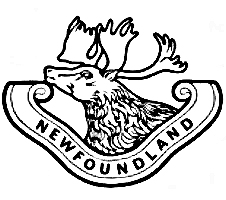
Insignia of the Royal Newfoundland Regiment
The Royal Newfoundland Regiment can trace its beginnings to 1795, when Major Thomas Skinner was ordered to raise an infantry company of 600 men to be stationed at Signal Hill, a strategic fortification overlooking the city of St John’s in Newfoundland, Canada, to ward off an anticipated attack by the French. The troops comprised almost entirely men of Irish descent, many of whom were sympathizers to the United Irishmen. In April 1800, upwards of 50 of these sympathizers mutinied but were captured and executed or sent to Halifax for garrison duty. The Regiment was disbanded in March 1802. Just eight months later, Brigadier-General John Skerrett was ordered to raise a regiment in preparedness for aggression by Napoleonic France. Many of the officers who joined the Newfoundland Regiment of Fencible Infantry had previously served with the recently disbanded Regiment. In 1806, the unit was renamed the Royal Newfoundland Regiment following King George III’s conferral of the title ‘Royal’. The Regiment took part in the Anglo-American War of 1812-1815 and was disbanded in 1816.
When Britain entered the First World War on 4 August 1914, the Governor of Newfoundland, Sir Walter Davidson, offered that the dominion raise a regiment of 500 volunteers for overseas service. The first contingent of the Newfoundland Regiment left Canada on 3 October 1914 for training in England and Scotland. In February 1915, a second contingent of 244 men joined the Regiment.
The Newfoundland Regiment was sent from England to Gallipoli, where it landed on Suvla Bay on 19-20 September 1915 as part of the 88th Brigade of the 29th Division. Faced with harsh and difficult conditions, the regiment earned its first battle honour in November by capturing Caribou Hill, a high point used by Turkish snipers. After the evacuation of Gallipoli, the Regiment served on the Western Front and took part in the Battle of the Somme, the Battle of Arras and the Third Battle of Ypres. On 28 September 1917, King George V bestowed the Regiment with the prefix ‘Royal’ in recognition of its valour. The Regiment was disbanded in 1919.

